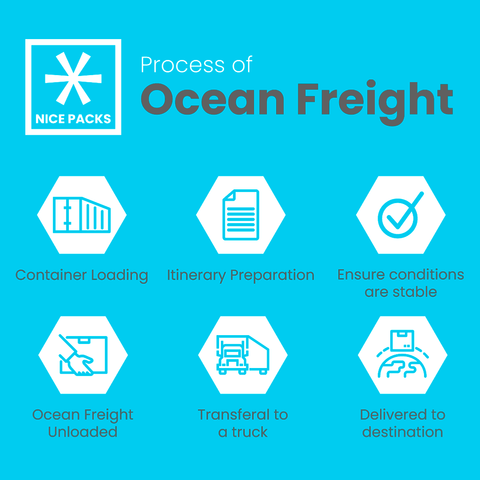Ocean shipping has benefited the global economy in several ways. Approximately 90% of our purchases are transported by sea. In this post, we'll try to explain the fundamentals of ocean freight to help you understand how international shipping works.
What Is Ocean Shipping?

Credit: Envato Elements/ Sandsun
Ocean freight or ocean shipping, often known as sea freight, is the international transport of goods by sea. It is by far the most popular mode of international cargo transport.
There are a variety of shipping alternatives available for various types of goods. Container shipping (containerization) and reefer shipping are one of the most popular which we will talk more about later.
Simply put, ocean freight is the transportation of products by the sea where large amounts of commodities are packed in containers and shipped internationally via sea channels. Exporters and importers use it as one of the most prevalent routes of transportation around the world.
What Is Containerization?
As previously stated, container shipping or containerization is one of the most popular ocean freight options. This is due to its relative safety and convenience of use.
Containerization is the technique of transporting goods in uniformly shaped and sized containers for shipping. These containers may hold almost anything, but they are especially useful for transporting manufactured goods. It is a container-based way of distributing goods.
LCL and FCL are the two main types of container shipping services available.
FCL Shipments
FCL(Full Container Load) shipments refer to transporting your goods in one or more containers that only you use. The container will only hold your products.
LCL Shipments
With LCL(Less Than Container Load) shipments, the products intended to be delivered are frequently less than what it takes to fill a container. Instead of paying for a container all to yourself, which might be costly, you can split the cost and share the container with other people's products.
What Are Reefer Ships?

Credit: Envato Elements/ KonstantinKolosov
Despite the fact that sea freight transportation takes a long time, it is an excellent option for transporting perishable commodities. Reefer ships, which are equipped with refrigerators, may transport fish, meat and dairy products, fruits, and vegetables. Cargo will not spoil during transportation due to the constant temperature inside.
What Kind of Cargo Is Commonly Transported by Sea?
The shipment agent will be able to determine whether ocean freight is appropriate for your shipment. As a general rule, packages weighing more than 100 kg or containing many cartons are better suited to sea freight.
Although there are some limitations on the goods that can be sent via sea freight, the majority of items are permitted. Hazardous items must be transported in special containers, whereas perishable goods must be transported in appropriate containers. You can also transport refrigerated or frozen products, as well as products such as sugar that must be kept dry throughout transit. To ensure that your products remain safe and cool during their journey, make sure to check out Nice Pack's dry ice packs!
Advantages of Ocean Freight

Credit: Envato Elements/ Sandsun
Ocean freight has a number of advantages:
1) One of the main advantages is its capacity to handle huge shipments or bulky or heavy cargo. Depending on the size of the product and cargo, different-sized containers are available. This isn't all. Refrigerated products can also be transported by ocean freight. If you own a food company and want to ship globally, ocean shipping is a good option.
2) When compared to other modes of transportation, such as air, ocean freight shipping is more cost-effective.
3) Ocean shipping accident rates have decreased dramatically over the years. Unlike air freight, which has limits on the carriage of shipments, ocean shipping boats are increasingly designed to carry hazardous materials or even frozen food.
4) Finally, ocean shipping is more environmentally beneficial than other modes of global shipping because CO2 emissions and the carbon footprint are substantially smaller.
How Much Does Ocean and Sea Freight Cost?
When having items sent or importing goods from another country, there are several duties and charges to consider. It depends on your supplier's agreement.
The following fees may be charged:
- Fees for LCL and FCL
- Transportation Costs to the Loading Port
- Customs declaration for export
- Fees for loading ports and ocean freight Insurance
- Port fees at the final destination
- Customs clearance for imports
- Duty/tax on imports
- Transportation to and from the final destination port
- Fees connected to customs in the destination country (i.e. duty/tax)
- Handling fee at the destination port or terminal (i.e. THC)
- D/O (destination agent service fee)
What Is the Process of Ocean Freight?

Credit: Envato Elements/ siwabudv
The transportation of freight goods from the factory to the marketplace is a fascinating and complicated procedure. To get the most out of your supply chain, you need to be aware of all the stages of the ocean shipping process.
Container Loading of Ocean Freight
A steel cargo container or refrigerated container is loaded with finished goods. These containers look a lot like the trailer part of a tractor-trailer or semi-truck, but they're built to withstand being piled on a ship's deck and exposed to the harsh conditions of the open sea. Temperature control or other specialized procedures are used depending on the contents.
Management of Itineraries
Prior to the voyage, a logistics specialist from the shipping company prepares an itinerary and ensures that all conditions are stable. Logistics control personnel can make necessary revisions to itinerary plans if changes in the allocated shipping vessel, a customs difficulty, or a weather occurrence occur.
Unloading Ocean Freight
The procedure of unloading is substantially similar to that of loading. Containers are either temporarily stored in the yard or placed directly onto a truck and transported out of the port to a warehouse or distribution center as they are unloaded by gigantic cranes. If you're shipping refrigerated goods, they'll be loaded into refrigerated trucks right away.
Transferring to the Truck
The truck driver signs off on all accountability paperwork required by the shipper, receiver, and current port authorities before leaving. Contents may require examination for quality control or security, depending on the nature of the freight. Rail service may be used if goods must travel large distances.
Final Destination
When the contents arrive at their final destination, they are signed one last time and received by the receiver for distribution to the end-users.

Summary
The best shipping options for international trade are determined by the type of product you sell. Reefer ships are the greatest alternative if you're a business owner who needs to ship temperature-sensitive commodities in large quantities on a regular basis.
Are you looking for a thermal box or dry ice packs? Get in touch with us today!


